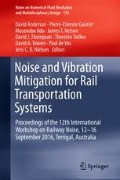Abstract
One of the most important environmental issues in densely populated areas is the problem of noise. Road traffic and railway noise and airports located in close proximity to the city is not only annoying for residents; it also leads to serious health issues and has an enormous negative economic impact. Due to this, it is of primary importance for city planners, engineers and politicians to make our cities quieter. An important source for railway noise is freight trains that operate around the clock. However, railway traffic has an important function for a sustainable mobility in Germany and Europe. Therefore, it is planned to transfer more traffic from the roads, waterways, or aircrafts towards the railway. Both the politicians and the majority of the people support this. In contrast to that is the enormous ecological “Achilles’ heel”, the noise emissions. Especially during the nights, the noise exposure is up to 25 dB(A) above the threshold given by the World Health Organization, which is to be aspired in terms of a precautious health protection of the people. Noise is a frequent reason for complaints and of high relevance with respect to any expansion, upgrade or construction measures of railway infrastructure. Along one of the most used railway corridor Rotterdam-Genoa, the opposition from residents is very high. Numerous people in Germany are protesting against railway noise, especially in the Middle Rhine valley. Under the Directives on rail traffic across Europe, the EU Commission has established pan-European noise thresholds for new types of rolling stock in the Technical Specifications for Interoperability (TSI). These emission values are valid for new rolling stock also in Germany. Since 1974 (western states of Germany) and 1990, respectively (eastern states of Germany), rail traffic on new lines is regulated in the 16th BImSchV (Traffic Noise Protection), which establishes noise immission limits for the protection of local neighborhoods. The most important consequence of the noise thresholds of the TSI is, that particularly noisy rolling stock fitted with cast iron block brakes is no longer permitted to be homologated (wagons of this type entering the market are no longer permitted). The challenge is now to replace these brakes in especially noisy freight wagons in the current rolling stock with quieter braking systems. As a financial incentive for rail operators to refit such rolling stock with quieter brakes, noise dependent track access charges are implemented in Germany. Additionally, there are a number of technical and legal measures available. In Switzerland and Germany for example, a ban is proposed for noisy freight wagons (non-compliant with TSI) from 2020 on. Access restrictions can yield a high level of protection and are efficient to protect the people from railway noise. The presentation will give an overview on these measures to abate efficiently the emissions of the rail freight traffic.
Access this chapter
Tax calculation will be finalised at checkout
Purchases are for personal use only
References
WHO Regional Office for Europe: Night Noise Guidelines for Europe, Copenhagen (2009)
WG Railway Noise of the European Commission: Position Paper on the European Strategies and Priorities for Railway Noise Abatement, (2003)
Commission Decision of 23 December 2005 concerning the technical specification for interoperability relating to the subsystem ‘rolling stock— noise’ of the trans-European conventional rail system (2006/66/EC) (2006)
IGES Institut GmbH; Technische Universität Berlin, Fachgebiet Schienenfahrzeuge; IVE Ingenieurgesellschaft für Verkehrs- und Eisenbahnwesen mbH; Prof. Dr. Eckhard Pache: Strategien zur effektiven Minderung des Schienengüterverkehrslärms (Strategy for an effective reduction of noise by rail freight transport) (2017)
Hecht; Zogg: Lärmdesign moderner Triebfahrzeuge am Beispiel der Lok 2000-Serie. Anwendung von Telemetrie, Intensitäts- und Arraymesstechnik. In: ZEV+DET Glaser Annalen 119(9/10), 467 (1994)
Johannsen: Der Einfluss der Oberflächenimpedanz auf das Abstrahlverhalten eines Schürze-Niedrigstschallschirm-Systems. Berlin (2005)
Hecht, W.: Low Noise Train (LNT) Präsentation Wien (Austria). Report Nr. 27/02. (2002)
Hecht; Czolbe 2008: BMU-Projekt Lärmminderungsmaßnahmen an drei Großdiesellokomotiven BlueTiger. In: ZEVrail Glasers Annalen 132, 11–12 (2008)
Voith Turbo: Wirkt in einem Zug. Antriebstechnik, http://resource.voith.com/vt/publications/downloads/1970_d_g_1480_d_atm_broschuere_gear_units_2012-09.pdf. (2014)
Author information
Authors and Affiliations
Corresponding author
Editor information
Editors and Affiliations
Rights and permissions
Copyright information
© 2018 Springer International Publishing AG, part of Springer Nature
About this paper
Cite this paper
Weinandy, R., Appel, P., Myck, T. (2018). Abatement of Railway Noise in Germany. In: Anderson, D., et al. Noise and Vibration Mitigation for Rail Transportation Systems. Notes on Numerical Fluid Mechanics and Multidisciplinary Design, vol 139. Springer, Cham. https://doi.org/10.1007/978-3-319-73411-8_9
Download citation
DOI: https://doi.org/10.1007/978-3-319-73411-8_9
Published:
Publisher Name: Springer, Cham
Print ISBN: 978-3-319-73410-1
Online ISBN: 978-3-319-73411-8
eBook Packages: EngineeringEngineering (R0)

